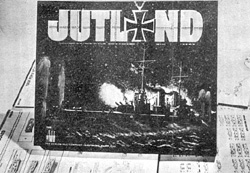 Avalon Hill's Jutland is not just a battle game--to the imaginative player it can be the basis for re-creating the entire naval war of 1914-1916, at least so fax as the struggle of surface fleets in the Atlantic and Baltic are concerned.
Avalon Hill's Jutland is not just a battle game--to the imaginative player it can be the basis for re-creating the entire naval war of 1914-1916, at least so fax as the struggle of surface fleets in the Atlantic and Baltic are concerned.
The allied naval policy called for a division of responsibilities. Britain, with the world's largest battle fleet, drew the big job.... pinning down the German High Seas Fleet. The French navy took care of the Mediterranean, later being aided by the Italian navy with elements of the Royal Navy (mostly old ships) coming down for the Gallipoli campaign.
With the big fleets In the north, Jutland was the only general engagement. There was, however, a certain amount of sparring. So the player who is going to the advanced or tournament game may wish to engage smaller fleet, units, perhaps Scout Group I of the High Seas Fleet versus a reinforced battle Cruiser Fleet in a sweep to draw down elements of the Grand Fleet. One German condition of victory might be the commitment of additional elements of the Grand Fleet south of the Dogger Bank, freeing the northern sector for the escape of German commerce raiders.
At Dogger Bank, Blucher, Seydlitz, Moltke, Van der Tann (battlecruisers), Derflinger, 4 light cruisers, and a destroyer flotilla met the British's Lion, Tiger, Princess Royal, New Zealand, Indefatigable, and cruisers and destroyers.
Games of a limited nature, or 'Rear Admiral's Games' make possible the use of the more complicated advanced and tournament rules without lengthening the period of play.
Demotion from fleet to rear admiral also makes possible the use of ship models instead of counters. (The Warspite class is available from Pyro in 1:1200 scale, and models in that scale are fairly easy to scratch build.) Some enthusiasts are now involved in dredging up every ship needed for the Jutland game, but for most of us a squadron or two is quite enough of an ambition.
With models, which are larger than the counters, a stick marked off in segments larger than, but proportionate to, the range finder, will be needed.
The great canal at Kiel gave the German Navy a means of dominating the Baltic while contesting the Atlantic without using the narrow and heavily mined Skaggerak. So long as the commanders of the allied and German fleets kept their minds on their business there is little likelihood that the Russian fleet could worm its way into a game with the Jutland rules. However, for the player diligent enough the hexagon off 'a reasonable facsimile of' the Baltic, there is hope for a little variety in that direction.
If, in the midst of a German sweep with the Scout Group to the south, there came word that a British force was demonstrating near the Skaggerak, and that the Russian fleet had sortied from Petersburg, it would be reasonable to detatch a slightly superior force through the Kiel canal to seek out the Russian navy, while the main force stood by to aid in the retreat of the Scout Group. Russian missions can be to either raid the German coast and escape, or to escape to the Skaggerak to join the British (they would need 5 moves at the Skaggerak for mine clearance.)
The Russian fleet had 4 first class ships building. No more than 2 should be allowed (on grounds of concentrating to finish 2 ships.) These are of the Kinbarn Class, with 14" 45's in 4x3gun turrets. There were an additional two ships, Slavs and Tsessarevitch with old battleship (B) characteristics, and the Bettlecruisers Gangoot, Poltova, Petropavlosk, and Sevastopol, with standard battleship speed and old battleship armament (12-12"50's), no correct that, that is Dreadnaught weight, with battlecruiser armor. Rourik, a battlecruiser, had old battleship armor, guns and tactical speed.
Russia also had cruisers with battle cruiser armor and 8" guns one 2 ship group with 1 gunpower (against capital ships) between them when broadside, and another with 2 offensive power against capital ships' broadside, 1 forward. Normal effect against light ships should be given these groups. There were also 4 cruisers of cruiser speed and normal light cruiser characteristics (the armored cruisers having battleship speed) and 6 standard 10 to 12 ship destroyer flotillas which could be thrown into a sortie.
An interesting "Rear Admiral's Game" could be devised between a Russian fleet bent on escaping via the Skaggerak or raiding the German coast and commerce and a reinforced German "Old Battleship" Squadron bent on crippling the Russian Fleet or driving it back into port within 48 hours.
Back to The Armchair General Vol. 1 No. 1 Table of Contents
Back to The Armchair General List of Issues
Back to MagWeb Master Magazine List
© Copyright 1968 by Pat Condray
This article appears in MagWeb (Magazine Web) on the Internet World Wide Web. Other military history articles and gaming articles are available at http://www.magweb.com
